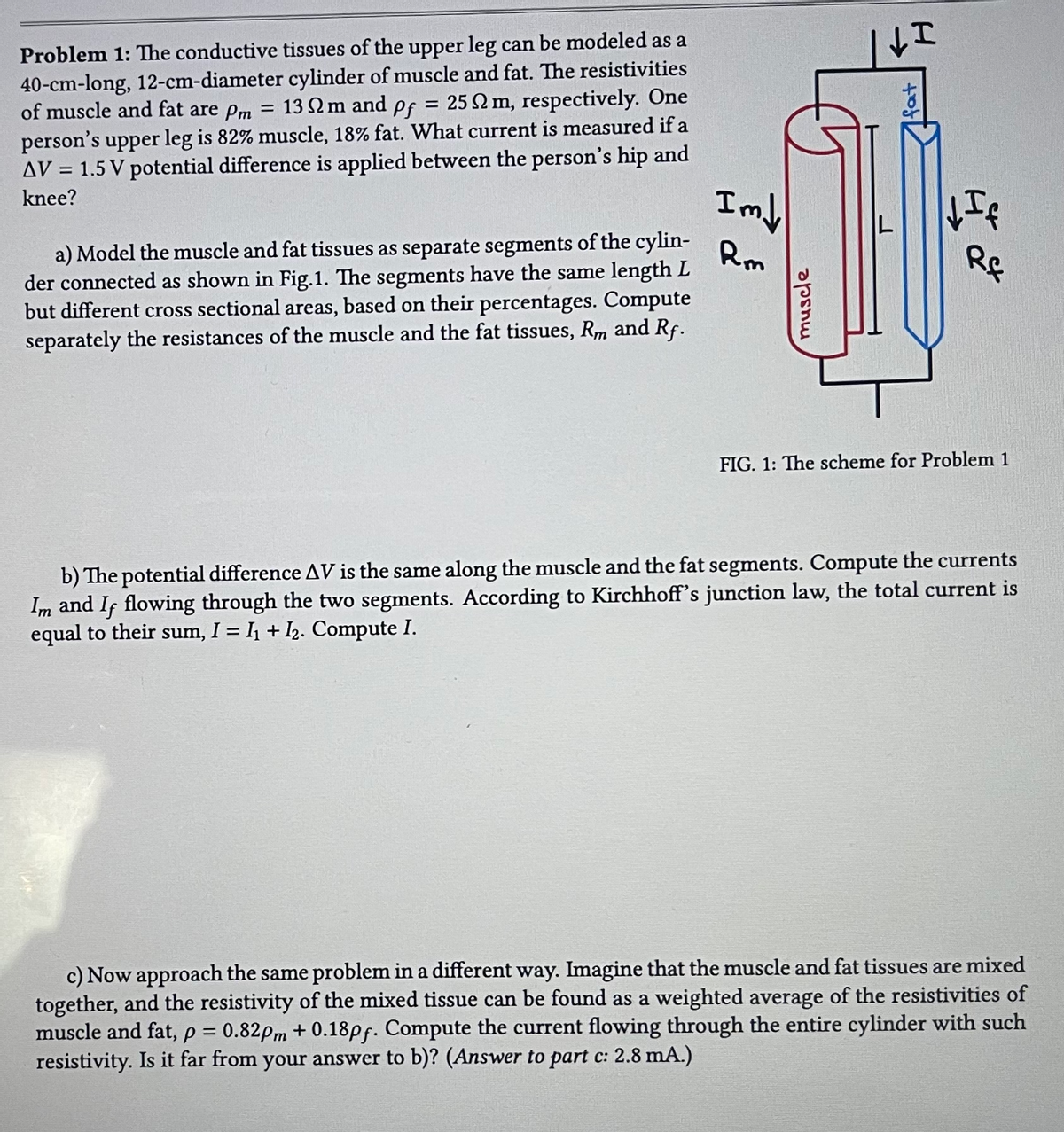Problem 1: The conductive tissues of the upper leg can be modeled as a 40-cm-long, 12-cm-diameter cylinder of muscle and fat. The resistivities of muscle and fat are Pm = 132 m and pf = 252 m, respectively. One person's upper leg is 82% muscle, 18% fat. What current is measured if a AV = 1.5 V potential difference is applied between the person's hip and knee? a) Model the muscle and fat tissues as separate segments of the cylin- der connected as shown in Fig.1. The segments have the same length L but different cross sectional areas, based on their percentages. Compute separately the resistances of the muscle and the fat tissues, Rm and Rf. Im↓ Rm muscle I fat ↓If Rf FIG. 1: The scheme for Problem 1 b) The potential difference AV is the same along the muscle and the fat segments. Compute the currents Im and If flowing through the two segments. According to Kirchhoff's junction law, the total current is equal to their sum, I = I₁+I₂. Compute I. c) Now approach the same problem in a different way. Imagine that the muscle and fat tissues are mixed together, and the resistivity of the mixed tissue can be found as a weighted average of the resistivities of muscle and fat, p = 0.82pm +0.18pf. Compute the current flowing through the entire cylinder with such resistivity. Is it far from your answer to b)? (Answer to part c: 2.8 mA.)
Problem 1: The conductive tissues of the upper leg can be modeled as a 40-cm-long, 12-cm-diameter cylinder of muscle and fat. The resistivities of muscle and fat are Pm = 132 m and pf = 252 m, respectively. One person's upper leg is 82% muscle, 18% fat. What current is measured if a AV = 1.5 V potential difference is applied between the person's hip and knee? a) Model the muscle and fat tissues as separate segments of the cylin- der connected as shown in Fig.1. The segments have the same length L but different cross sectional areas, based on their percentages. Compute separately the resistances of the muscle and the fat tissues, Rm and Rf. Im↓ Rm muscle I fat ↓If Rf FIG. 1: The scheme for Problem 1 b) The potential difference AV is the same along the muscle and the fat segments. Compute the currents Im and If flowing through the two segments. According to Kirchhoff's junction law, the total current is equal to their sum, I = I₁+I₂. Compute I. c) Now approach the same problem in a different way. Imagine that the muscle and fat tissues are mixed together, and the resistivity of the mixed tissue can be found as a weighted average of the resistivities of muscle and fat, p = 0.82pm +0.18pf. Compute the current flowing through the entire cylinder with such resistivity. Is it far from your answer to b)? (Answer to part c: 2.8 mA.)
Related questions
Question
Hello, I am having trouble with this problem, I was wondering if you can help me part A, Part B, and Part C and can you label which one is which, thank you

Transcribed Image Text:Problem 1: The conductive tissues of the upper leg can be modeled as a
40-cm-long, 12-cm-diameter cylinder of muscle and fat. The resistivities
of muscle and fat are Pm = 132 m and pf = 252 m, respectively. One
person's upper leg is 82% muscle, 18% fat. What current is measured if a
AV = 1.5 V potential difference is applied between the person's hip and
knee?
a) Model the muscle and fat tissues as separate segments of the cylin-
der connected as shown in Fig.1. The segments have the same length L
but different cross sectional areas, based on their percentages. Compute
separately the resistances of the muscle and the fat tissues, Rm and Rf.
Im↓
Rm
muscle
I
fat
↓If
Rf
FIG. 1: The scheme for Problem 1
b) The potential difference AV is the same along the muscle and the fat segments. Compute the currents
Im and If flowing through the two segments. According to Kirchhoff's junction law, the total current is
equal to their sum, I = I₁+I₂. Compute I.
c) Now approach the same problem in a different way. Imagine that the muscle and fat tissues are mixed
together, and the resistivity of the mixed tissue can be found as a weighted average of the resistivities of
muscle and fat, p = 0.82pm +0.18pf. Compute the current flowing through the entire cylinder with such
resistivity. Is it far from your answer to b)? (Answer to part c: 2.8 mA.)
Expert Solution
This question has been solved!
Explore an expertly crafted, step-by-step solution for a thorough understanding of key concepts.
This is a popular solution!
Trending now
This is a popular solution!
Step by step
Solved in 5 steps
